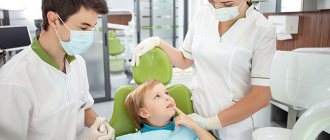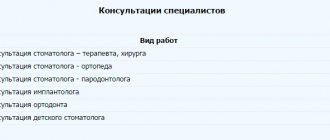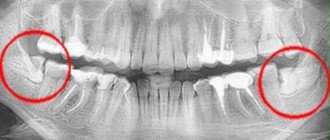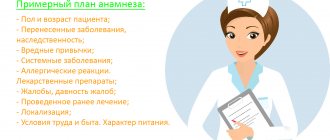In dentistry, the practice of working with four hands is the most popular and convenient format for interaction between a doctor and his assistant, therefore, in clinics engaged in this area, recruitment agencies try to recruit experienced and reliable employees not only for the position of doctors, but also for vacancies of junior medical staff. What are the responsibilities of a dental assistant, what does he do in the workplace, what rights does he have and what is the scope of his responsibility - comprehensive information in the article.
What kind of profession is a dental assistant?
A dental assistant is the right hand of any dentist. Without him, no clinic will be able to function normally, since he performs all the preparatory work in the doctor’s office, helps him at appointments, and maintains documentation. The remaining responsibilities of a dental assistant are determined by his immediate superiors - the doctor and the head of the clinic (department). Typically, these specialists provide paramedical care without interfering in the treatment process, but sometimes doctors delegate some of their own powers, instructing an assistant to perform an initial examination of the patient or carry out simple manipulations with him.
This profession is quite in demand in the labor market, because there are a lot of offices providing dental and oral cavity treatment services in our country. The responsibilities of a dental assistant in a private clinic may differ from those performed by a specialist in a budget organization. Firstly, because in each institution the doctor works with materials familiar to him and using a certain technology, and secondly, because doctors in private practice, as a rule, have more modern equipment, they modernize patient management protocols and respond faster to innovations in your field of activity.
take, intercept, hold
The assistant takes or intercepts the instrument from the doctor’s hands.
The doctor takes or intercepts the instrument from the assistant’s hands.
Typical shortcomings and mistakes in the “Take, intercept, hold” aspect
Assistant:
- does not know how to replace instruments from one to another, does not know how to hand instruments to the doctor;
- does not know or does not foresee what instrument the doctor will need at the next moment (for example, during restoration of a tooth with a composite material);
- does not come to the doctor’s aid during treatment when it is necessary to hold the patient’s cheek or tongue, matrix, or suture material;
- is in a hurry or abrupt in movements with instruments - there is a danger of injury to the patient or doctor;
- does not comment on his actions for the doctor and patient if necessary.
Doctor:
- relies only on himself, because he does not count on the effective help of an assistant or does not trust him;
- does not verbalize the request for the assistant, unreasonably relying on his intelligence.
Dental Assistant Education
In order to work as a dental assistant, you must have a secondary specialized medical education. At the same time, for some clinics it is important that the candidate graduate from any medical college with a specialty in “Nursing,” while others fundamentally require a diploma in the specialty “Preventive Dentistry.”
In addition to a diploma confirming a level of knowledge sufficient for work, the assistant must promptly obtain a state specialist certificate. Let us remind you that according to the law, employers and regulatory authorities do not have the right to demand this document from graduates of educational institutions if they completed their studies less than five years ago. A specialist certificate is not just another piece of paper, but a serious certification document that guarantees that a candidate for a vacant position in a clinic will be able to perform the duties of a dental assistant. The certificate confirms that the health worker has sufficient theoretical and practical skills.
Educational process
To become an assistant in an dental center, it is enough to have any medical diploma that gives the right to hold the position of a nurse. Nursing, medical or midwifery faculty at a medical college would be suitable. Studying to become a nurse is a relatively simple path, since you can enroll after 9 years of school and obtain a certificate in 3 years and 10 months. Graduates of 11th grade study for 2 years and 10 months. It is impossible to become a paramedic without secondary general school education, and the duration of study in this area for all students is 3 years and 10 months.
To apply for admission, you must provide college admissions officers with a certificate, identification card, military ID (if available) and a certificate. Entrance tests are conducted in the format of computer testing. The exam evaluates the psychological readiness of the applicant to perform the professional duties of a physician. Some educational institutions require you to take biology, chemistry or Russian.
4-hand operation
In advertisements for dental assistant searches, the authors tend to often indicate that the candidate must have sufficient skills and qualifications to work with a doctor four-handed. What does this mean? The doctor is forced to perform all dental procedures quite quickly: many filling materials, as well as medications, must be removed from the packaging as soon as possible and used for their intended purpose. At the same time, it is important to follow the stages of work, not to confuse anything. Sometimes the work requires illuminating the area of dental reconstruction with a special lamp, which the doctor himself cannot do. Also, the doctor often needs a quick change of working tools, attachments on drills, mirrors, and forceps. It is to quickly perform all these tasks that a dental assistant is required. The assistant’s responsibilities are to always be within the doctor’s reach, quickly respond to his requests and know the sequence of his main actions in order to be able to predict the boss’s “order.”
If the tandem is successful, and the doctor and his assistant understand each other perfectly, then their productivity increases significantly. That’s why clinics encourage working with 4 hands. The duties of a dental assistant do not require a person to show excessive initiative; on the contrary, it is important that the assistant maintain business and personal subordination with the doctor, be diligent, attentive and responsible.
Setting the lamp light at the beginning of treatment
Note. A dental unit lamp is a device for illuminating the surgical field in the patient’s mouth. The radiation intensity of the lamp in modern installations is more than 20,000 Lux. There is a light intensity regulator.
The assistant turns on and directs the light of the dental unit lamp, taking into account:
- will it be convenient for the doctor to work;
- Will the patient be comfortable?
Assistant actions:
- before turning on the lamp, offers the patient sunglasses,
- the lamp is first directed to the patient's abdominal area,
- then the lamp light turns on,
- the light of the lamp moves to the area of the lower third of the face.
Typical shortcomings and errors in the aspect “Installing the lamp light at the beginning of treatment”
Assistant:
- does not offer sunglasses to the patient before treatment;
- early, a few minutes before the start of the examination, turns on the lamp light;
- incorrectly sets the lamp light - either it hits the patient’s eyes, or is directed past the doctor’s working area in the patient’s mouth (the doctor is forced to change the position of the lamp);
- forgets to lower the installation bracket with the lamp down, forcing the doctor to get up from the chair to set the lamp light in the desired position.
Doctor:
- does not offer sunglasses to the patient before treatment unless the assistant does so;
- without waiting for the help of an assistant, he himself lowers the installation bracket with the lamp;
- sets the position of the lamp relative to the patient’s lower or upper jaw.
Peri-medical activities of a dental assistant
The range of responsibilities assigned to a dental assistant depends greatly on the doctor himself, as well as the services he provides. Thus, general practitioners who deal with surgical and therapeutic manipulations, prosthetics, orthodontics and orthopedics have more stringent requirements for assistants. The responsibilities of dental assistants also differ due to the fact that they may be involved in the treatment process to varying degrees. Paramedical care consists of performing the following types of work:
- compliance with sanitary standards in the office, timely disinfection, weekly general cleaning (washing floors, walls, ceilings, windows, furniture and equipment);
- preparing instruments for use, disinfecting them, sterilizing them;
- cleaning the doctor’s workplace at the end of the working day, including disinfection of handpieces, turning off equipment;
- keeping records of medications, consumables and dressings, issuing them to the doctor, monitoring expiration dates and leftovers;
- maintaining documentation, registering patients, filling out various reporting forms, making entries in journals on cleaning, serviceability of equipment, sterilization of instruments.
And, of course, the main responsibilities of a dental assistant are to quickly carry out the doctor’s orders during work, meet patients at the reception desk and escort them to their chair.
Put away
The assistant cleans:
- in the patient’s oral cavity: rolls, balls, retraction threads, fragments, crumbs;
- contamination from the patient's face and glasses;
- contamination from working tools;
- moves the armrest and table of the dental unit at the end of treatment; instruments into the cassette from the dental unit table.
Typical shortcomings and errors in the “Remove” aspect
Assistant:
- waits until the doctor reminds him to help remove balls, rollers, retraction threads, fragments of hard tooth tissue, crumbs of filling material, dirt from the patient’s glasses and the doctor’s mirror from the patient’s mouth during treatment;
- does not notice dirt on the patient’s face remaining after treatment, hygienic cleaning, or taking impressions;
- does not warn the patient that he will remove something from his face, and does this unexpectedly for the patient;
- when necessary, does not comment on his actions for the doctor and the patient.
Doctor:
- acts for the assistant, removing balls, rollers, retraction threads, fragments of hard dental tissues, crumbs of filling material, dirt from the patient’s glasses and doctor’s instruments from the patient’s mouth;
- does not remind the assistant of the need for specific actions when he is not performing his duties.
Assistant with partial physician responsibilities
In many clinics, assistants are also responsible for conducting diagnostic procedures, which means they must be able to work with a visiograph and x-ray machine, using them to take targeted, intraoral and panoramic photographs.
If the assistant has a fairly good theoretical and practical knowledge base, the doctor can trust him to perform more complex tasks. In addition to all of the above, the following responsibilities will be assigned to his shoulders:
- initial examination of the patient;
- partial implementation of preventive, therapeutic and diagnostic procedures;
- assistance in selecting filling material;
- maintaining cleanliness in the patient’s mouth while the doctor is working (removing saliva, blood, rinsing the mouth).
Filling out the patient chart is also the responsibility of the dental assistant. What should he indicate there? The name of the patient, his address, date of birth and age, the amount of work the doctor did, his instructions.
Replace
The assistant changes depending on the stage of reception:
- boron in a mechanical, turbine tip;
- tips on the physiodispenser in accordance with the required speed limit;
- roller balls in the patient’s mouth;
- the instrument used for the next stage of treatment;
- broken, dirty, sterilized instrument in a cassette.
Note. Opening a package with a sterile instrument should make as little noise as possible, especially if the doctor is talking to the patient at this time. The doctor, while the assistant is replacing something, has the opportunity to:
- offer the patient a break to rest;
- maintain contact with the patient;
- inquire about his well-being;
- inform the patient about the upcoming procedure or stage of treatment;
- relax.
Typical shortcomings and errors in the “Replace” aspect
Assistant:
- cannot replace burs in the handpiece, equipment (for example, a device for removing hard plaque (piezon) with a device that removes pigmented plaque - air flow, used instruments in a cassette (tray) due to ignorance or misunderstanding of the essence of the manipulation being performed;
- does not comment on his actions for the doctor and the patient in the event of a pause when replacing something;
- with noise, in response to the doctor’s phrase addressed to the patient, he opens the package with a sterile instrument;
- does not invite the patient to rest, relax, using a pause in work when something is replaced.
Doctor:
- replaces burs, instruments, roller balls in the patient’s mouth (in simple cases), without relying on the effective assistance of an assistant or not trusting him;
- does not verbalize the request for the assistant, unreasonably relying on his intelligence;
- does not fill the pause with communication with the patient when something is replaced.
Job Description for Dental Assistant
Each clinic develops its own job description for employees. According to this document, the nuances of the employees’ work are determined: rights, areas of responsibility, duties and requirements. A dental assistant is a serious position, so the instructions for him must include the following mandatory points:
- General provisions (education, work experience, additional skills and abilities; clarification of the service hierarchy; legislative standards required in the work; the acting assistant is indicated in the event of his absence).
- Job responsibilities - a list of tasks that the assistant will need to perform.
- Employee rights.
- The responsibility he bears to the clinic and patients.
The job description must be signed by both the head of the clinic and the subordinate. The document is marked with the date of its creation. In this case, one copy remains in the clinic, and the other is given to the dental assistant.
Light adjustment
Assistant:
- directs the light of the lamp so that it directly illuminates the area in the patient’s oral cavity required for examination or treatment;
- sets the lighting differently for each jaw: when working on the lower jaw, the light is directed straight down; when working on the upper jaw, the light should be directed at an angle;
- makes sure that the light does not shine in the patient’s eyes;
- promptly turns on, turns off and adjusts the brightness of the lamp depending on the stage of treatment (for example, when selecting burs or working with light-curing materials, the lamp light should be dimmed).
Notes:
- the assistant should be able to reorient or turn off the lamp at any time, so it should be at a distance no further than his outstretched arm;
- The assistant turns off the lamp light in the following cases:
- every time a doctor talks with a patient, discussing a treatment plan (prosthetics), giving recommendations, making a prognosis;
- when determining the color of a future restoration or prosthesis, when natural lighting is needed.
Typical shortcomings and errors in the “Light adjustment” aspect
Assistant:
- incorrectly sets the light of the installation lamp - the area of the surgical field is not illuminated or is not illuminated enough;
- does not dim the brightness of the lamp when working with light-curing materials in the patient’s oral cavity;
- does not turn off the lamp light when it is possible to give the patient a rest (for example, when changing the bur).
Doctor:
- adjusts the light of the lamp independently, not trusting the assistant to do this or anticipating his actions when he is slow.
Work schedule
The job responsibilities of a dental assistant can be roughly divided into two components. The first is precisely the workflow and its interaction with the doctor. In addition, the dental assistant must have time to put the office in order, order medications, instruments, consumables on time, disinfect and sterilize instruments. Fulfilling these duties cannot be at the expense of providing assistance to the physician when required.
An assistant, as a rule, comes to work before the doctor and leaves later than him - in order to have time to prepare the workplace before seeing patients and to always be in the doctor's support. Dentists usually work in shifts - before or after lunch. Assistants are also not in the clinic from dawn to dusk; their working day depends on the doctor’s schedule, but it is longer than that of their immediate superior.
Additional Responsibilities
However, the job description does not end there. The assistant also has secondary responsibilities.
They include:
- General cleaning of the office once a week - including washing the walls and ceiling.
- Window cleaning according to schedule.
- Meeting the patient at the reception desk and accompanying him to the office.
- Attendance at meetings, conferences, and official events.
- Providing emergency medical care to the patient if required.
The dental assistant, like other clinic employees, participates in the discussion of work issues, makes suggestions for improving the activities of the institution and the provision of services, and makes comments.
The doctor and assistant actively cooperate, jointly conduct the process of medical care, and consult. The doctor and assistant act together harmoniously - like a single organism.
Assistant training process on video:
Records management
The second component of the responsibilities of a dental assistant is maintaining reporting and current documentation. The assistant fills out patient charts (in paper or electronic form) and keeps various logs:
- on safety precautions;
- medication accounting;
- cleaning;
- disinfection and sterilization;
- equipment serviceability.
Entries in these documents must be made in a timely manner; patient cards are filled out immediately - at the appointment.
Shine with curing lamp
The doctor applies an adhesive system into the tooth cavity (or onto a ceramic structure), places a portion of light-curing material, restoring the tooth cavity.
The assistant monitors the doctor’s actions in the patient’s oral cavity; prepares the solar lamp, setting the desired mode; highlights a portion of the introduced material.
Typical shortcomings and errors in the aspect “Shine with a polymerization lamp”
Assistant:
- did not prepare the polymerization lamp for reception, it is turned off from the network or the battery is discharged;
- works with a lamp without protective glasses or a shield, violating personal safety precautions;
- illuminates the material in less time than is necessary in this case;
- presses the nozzle of the polymerization lamp to the filling material;
- highlights the material from the wrong side.
Doctor:
- takes upon himself the illumination of a portion of the material, without trusting this to an assistant;
- does not verbalize instructions to the assistant on how best to cover the material in a given case, unreasonably relying on his intelligence;
- violates safety regulations by monitoring the actions of an assistant while illuminating material without protective glasses or a face shield;
- does not explain to the patient (in justified cases) at what stage the tooth restoration is carried out and how long until completion.
Rights and responsibilities of a dental assistant
The rights of a dental assistant are not limited solely to the provisions of the labor legislation of the country in which he works - official employment, compliance with the work and rest regime, the availability of a social package, etc. They also relate to the purely professional employment of a specialist. The assistant must fully receive the information necessary for him to perform his duties, and he also has the right to demand management support to perform the functions assigned to him.
A dental assistant is a financially responsible person. Moreover, the medical assistant is responsible not only for the equipment, instruments and medications entrusted to him, but also for his own actions. If, due to his negligence, inattention or unprofessional actions, the health or life of the patient was harmed, he will be held accountable for this in court. In case of serious mistakes, the physician assistant may be fined, disqualified from working in his position, or imprisoned in a correctional facility.
Supply of tools and materials
The assistant gives the doctor: a carpule syringe with anesthetic, instruments, materials that are needed at this stage of treatment, a machine tip with a bur.
Rules for administering anesthetic:
- the assistant hands over the carpule syringe, clearly naming the anesthetic,
- the doctor intercepts the syringe,
- the assistant removes the protective cap from the needle,
- both partners verbally and non-verbally relax the patient.
Ten rules for filing instruments
- Never pass instruments over the patient's head or face.
- The assistant passes the instrument over the patient's chest so that he does not experience discomfort.
- In the case of transferring a surgical instrument (for example, forceps for tooth extraction), it is allowed to transfer it behind the patient's head.
- Always hand the instrument to the doctor with the working end towards the tooth being prepared so that the handle of the instrument is in the closest and most convenient position for gripping to the doctor’s leading hand.
- Handle sharp instruments or instruments with two handles (forceps, scissors) carefully to avoid injury to the patient or doctor.
- Avoid collision of the assistant's hands with the doctor's hands.
- The required instrument must be placed in the hands of the doctor in such a way as to ensure interception and prevent the instrument from falling.
- The instrument must be given and received in such a way that the doctor’s hand makes as little movement as possible.
- Do not pick up the instrument if it has fallen to the floor.
- If the instrument falls on the floor, then you should note to the patient that you will replace the instrument with a sterile one. Otherwise, the patient may view the instrument falling as a situation that prevents treatment from continuing properly.
Note. When the assistant puts the protective cap on the carpule needle after injecting the anesthetic, he needs to be as careful as possible and not rush, so as not to injure himself - a needle prick. Please remember that the needle can become infected.
Typical shortcomings and errors in the aspect “Supply of tools and materials”
Assistant:
- untimely or late provides the doctor with the necessary instrument or material, because he does not know or does not understand what the doctor will need next;
- does not know the technique of mixing cements, impression materials (when manually mixing dental cements and impression materials, it is necessary to strictly take into account the ratio of components determined by the manufacturer, the mixing time and the homogeneity of the resulting material);
- hands the doctor instruments over the patient's face or head - there is a danger of injuring the patient and frightening him;
- the instrument is transferred within the patient’s field of vision, which causes psychological stress;
- is in a hurry or abrupt in movements with instruments - there is a danger of injury to the patient or doctor;
- does not announce the name of the anesthetic, material, instrument to the doctor - an error may occur, so the doctor is forced to double-check the assistant by asking questions.
Doctor:
- he himself takes the necessary tools from the cassette (tray), without relying on the timely help of an assistant or without trusting him;
- does not verbalize the request for the assistant to submit the necessary, relying on his intelligence, as a result, the treatment process slows down, the doctor begins to get nervous.
Wage
The work of a dental assistant is assessed quite well. The highest salaries in this industry are, of course, noted in Moscow. In large dental clinics, assistants are paid from 60-75 thousand rubles per month, while those who work in smaller offices have to be content with 25-30 thousand rubles. There are a lot of open vacancies on labor exchanges, so a dental assistant can find a good job quite quickly. In the regions, things are not so rosy - there are much fewer places there, and salaries are an order of magnitude lower. The average level is 20-25 thousand, while some clinic assistants are willing to pay no more than 15 thousand rubles per month.
Responsibility
The dental assistant is responsible for:
4.1. For non-fulfillment or improper fulfillment of the duties provided for in these instructions - within the limits determined by the labor legislation of the Russian Federation.
4.2. For offenses committed in the course of carrying out their activities - within the limits determined by the current administrative, criminal and civil legislation of the Russian Federation.
4.3. For causing material damage to the employer - within the limits determined by the current labor and civil legislation of the Russian Federation.
The job description has been developed in accordance with [name, number and date of document].
Place of work
Now I work in a laboratory that is not attached to any clinic. We take orders from all over the city and region from dentists who do not have their own dental technicians. The managers, husband and wife, are dental technicians themselves. Employees are valued, encouraged to strive for development, paid for for courses, and supported in their interest in work. The atmosphere in the team is very friendly, there are no misunderstandings or resentments towards each other, and for me this is a huge plus.
The team is small - 10 people. All the guys are young, with 2-9 years of work experience.










